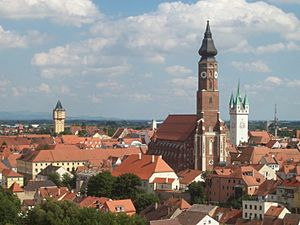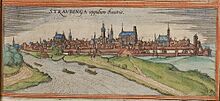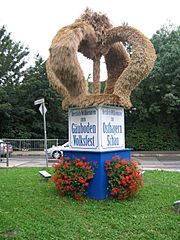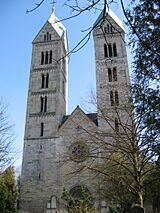Straubing facts for kids
Quick facts for kids
Straubing
|
|||
|---|---|---|---|

View of Straubing
|
|||
|
|||
| Country | Germany | ||
| State | Bavaria | ||
| Admin. region | Niederbayern | ||
| District | Urban district | ||
| Elevation | 322 m (1,056 ft) | ||
| Population
(2022-12-31)
|
|||
| • Total | 49,164 | ||
| Time zone | CET/CEST (UTC+1/+2) | ||
| Postal codes |
94301–94315
|
||
| Dialling codes | 09421 | ||
| Vehicle registration | SR | ||
| Website | www.straubing.de | ||
Straubing is an important city in Lower Bavaria, which is a region in southern Germany. It's known as an "independent city," meaning it manages its own local government, separate from a larger district. Straubing is also the main city for the Straubing-Bogen district.
Every August, a big event called the Gäubodenvolksfest takes place here. It's the second largest fair in all of Bavaria, attracting many visitors. The city is located right on the Danube River, in a fertile area called the Gäuboden.
Contents
History of Straubing
People have lived in the area around Straubing for a very long time, even since the Neolithic Age (the New Stone Age).
How the Romans Shaped Straubing
Around 16–14 BC, the Romans took control of this region. This changed everything! Even today, you can find many signs of the 400 years the Romans were here. For example, the famous 'Römerschatz' (Roman treasure) was found in 1950. This amazing collection of Roman items is now on display at the Gäubodenmuseum. The Romans called this place Sorviodurum, and it was an important military base for their soldiers.
The Bavarii and the City's Name
After the Roman Empire ended, Straubing became a main settlement for the Bavarii people. They mostly settled near St. Peter's Church, which was built in the 9th century. Following their customs, the Bavarii named their settlement after their leader, Strupinga. Over time, this name changed and became "Straubing."
The New Town and Dukes
In 1218, a new part of the city was started by Duke Ludwig I Wittelsbach of Bavaria. This new area is now the busy center of Straubing, with many shops, restaurants, and a pedestrian zone. Many buildings there still look like they did in medieval times.
Straubing even became the capital of its own small state, the Duchy of Bavaria-Straubing, in 1349. This happened when Bavaria was divided among the sons of Louis IV, Holy Roman Emperor. Later, in 1429, Straubing became part of the land ruled by Ernest, Duke of Bavaria-Munich. Duke Ernest is known for ordering the death of Agnes Bernauer in Straubing. Her grave has never been found, but there is a chapel built by Duke Ernest in the graveyard of St. Peter's Church.
Wars and Modern Times
In 1633, during the Thirty Years' War, the Swedish army attacked and took over the city.
Between 1933 and 1945, during a very sad time in history, most members of Straubing's small Jewish community were killed or forced to leave. However, by 2006, Straubing had a lively Jewish community again with about 950 members.
During World War II, in 1944 and 1945, Straubing was bombed several times by American planes. The local military hospital was badly damaged. In November 2016, a fire destroyed a large part of the old medieval city hall.
Today, Straubing has many industrial areas and a port on the Danube River. This port connects to the Rhine-Main-Danube Canal, which links the North Sea all the way to the Black Sea. Straubing is also a center for new technology in Bavaria, especially in biotechnology.
Main Sights of Straubing
Straubing was one of five main homes for dukes in medieval Bavaria. Because of this, its old town has many beautiful Gothic buildings.
- The Romanesque Church of St. Peter was built in the 12th century.
- The Gothic City Tower was started in 1316.
- The Gothic city hall, though parts were damaged by a fire in 2016.
- The medieval ducal castle, or Herzogsschloss. Duke Albert I began building it in 1356.
- The Gothic Basilica of St. Jacob is the largest main church in Straubing. Its construction began in 1393.
- The Church of St. Vitus is home to Germany's oldest existing group of people who support each other, called the St. Salvator-Confraternity.
- The Carmelite monastery and Church of the Holy Spirit have been here since 1368. It's the only monastery that survived when others were closed down in 1802.
- The Church of St. Ursula was designed by the famous Asam brothers.
- The Baroque Trinity Column stands in Theresien Square.
- The Water Tower.
- Sossau pilgrimage church.
- Straubing Zoo is the only zoo in East Bavaria.
Climate in Straubing
| Climate data for Straubing (1991–2020 normals) | |||||||||||||
|---|---|---|---|---|---|---|---|---|---|---|---|---|---|
| Month | Jan | Feb | Mar | Apr | May | Jun | Jul | Aug | Sep | Oct | Nov | Dec | Year |
| Mean daily maximum °C (°F) | 1.6 (34.9) |
4.4 (39.9) |
9.5 (49.1) |
15.5 (59.9) |
19.6 (67.3) |
23.1 (73.6) |
25.0 (77.0) |
24.7 (76.5) |
19.5 (67.1) |
13.7 (56.7) |
6.9 (44.4) |
2.8 (37.0) |
13.9 (57.0) |
| Daily mean °C (°F) | −1.1 (30.0) |
0.6 (33.1) |
4.6 (40.3) |
9.7 (49.5) |
14.0 (57.2) |
17.5 (63.5) |
19.0 (66.2) |
18.6 (65.5) |
13.9 (57.0) |
9.1 (48.4) |
4.0 (39.2) |
0.4 (32.7) |
9.2 (48.6) |
| Mean daily minimum °C (°F) | −4.2 (24.4) |
−3.2 (26.2) |
−0.1 (31.8) |
3.4 (38.1) |
7.9 (46.2) |
11.3 (52.3) |
12.7 (54.9) |
12.5 (54.5) |
8.5 (47.3) |
4.7 (40.5) |
0.9 (33.6) |
−2.3 (27.9) |
4.3 (39.7) |
| Average precipitation mm (inches) | 47.3 (1.86) |
40.7 (1.60) |
48.2 (1.90) |
35.1 (1.38) |
77.0 (3.03) |
80.7 (3.18) |
76.4 (3.01) |
72.4 (2.85) |
60.5 (2.38) |
48.7 (1.92) |
47.2 (1.86) |
49.3 (1.94) |
684.4 (26.94) |
| Average precipitation days (≥ 1.0 mm) | 16.2 | 13.8 | 14.1 | 11.6 | 15.2 | 13.9 | 15.0 | 13.4 | 12.8 | 13.9 | 13.9 | 16.9 | 170.8 |
| Average snowy days (≥ 1.0 cm) | 14.6 | 11.3 | 3.2 | 0.1 | 0 | 0 | 0 | 0 | 0 | 0 | 2.0 | 7.0 | 38.2 |
| Average relative humidity (%) | 88.5 | 84.1 | 76.7 | 71.0 | 72.3 | 73.5 | 72.4 | 73.6 | 80.1 | 86.4 | 90.4 | 90.3 | 79.9 |
| Mean monthly sunshine hours | 52.7 | 90.2 | 144.0 | 197.0 | 222.5 | 243.5 | 248.6 | 229.4 | 168.0 | 109.2 | 52.4 | 45.2 | 1,797.9 |
| Source: World Meteorological Organization | |||||||||||||
Festivals and Events
Straubing hosts many fun festivals and cultural events throughout the year:
- Straubinger Frühlingsfest: A spring festival held every year.
- Gäubodenvolksfest and Ostbayernschau: The big fair mentioned earlier, combined with an exhibition for East Bavaria.
- Museum: There is a museum with many interesting Roman artifacts.
- Agnes-Bernauer-Festspiele: A historical play performed to remember Agnes Bernauer.
- Straubing Zoo: A great place to see animals.
- bluetone (formerly Jazz an der Donau): One of the biggest jazz festivals in Europe.
- Bürgerfest: A "burgher festival" held every two years in the historic city center.
Sports in Straubing
Straubing is home to several sports teams:
- Ice hockey: The Straubing Tigers play in the DEL, which is the highest German league.
- American football: The Straubing Spiders team was founded in 1985.
- Harness racing: Straubing has a top-level harness racing track called Trabrennbahn Straubing.
- Volleyball: A women's volleyball team plays in the German Women's Volleyball League, the highest league in Germany.
Education in Straubing
Straubing is a place for learning, with several important educational institutions:
- The Technical University of Munich has a campus here that specializes in renewables (like solar or wind energy).
- A Fraunhofer Institute for boundary and biodiversity engineering is also located in Straubing. This institute does research on how living things interact with their environment.
Straubing has four gymnasiums, which are types of grammar schools:
- Anton-Bruckner-Gymnasium
- Gymnasium der Ursulinen
- Johannes-Turmair-Gymnasium
- Ludwigsgymnasium
Twin Towns – Sister Cities
Straubing has special partnerships with other cities around the world. These are called "twin towns" or "sister cities":
Notable People from Straubing
Many interesting people have come from Straubing:
- Agnes Bernauer (c. 1410 – 1435), known for her connection to Duke Albert III of Bavaria.
- Thomas Naogeorgus (1508–1563), a writer of plays and a humanist.
- Ulrich Schmidl (1510–1579), an explorer and writer.
- Jakob Sandtner (16th century), a master wood turner.
- Emanuel Schikaneder (1751–1812), a theater manager, writer, actor, and composer.
- Joseph von Fraunhofer (1787–1826), an important optician and physicist.
- Carl Spitzweg (1808–1885), a romantic painter who worked here.
- Arthur Achleitner (1858–1927), a writer.
- Otto Ritter von Dandl (1868–1942), a politician.
- Hans Adlhoch (1883–1945), a member of the Reichstag.
- Rex Gildo (1936–1999), a pop singer.
- Michael Karoli (1948–2001), a guitarist.
- Margot Mahler (1945–1997), an actress.
- Claus Richter (born 1948), a journalist.
- Gerda Hasselfeldt (born 1950), a politician and former federal minister.
- Ewa Klamt (born 1950), a politician.
- Siegfried Mauser (born 1954), a pianist and music expert.
- Thomas Stellmach (born 1965), a director and Oscar winner.
- Gerold Huber (born 1969), a pianist.
- Christian Gerhaher (born 1969), a baritone singer.
- Michael Stumpf (born 1970), a systems biologist.
- Markus Weinzierl (born 1974), a football player and coach.
- Elli Erl (born 1979), a singer-songwriter.
See also
 In Spanish: Straubing para niños
In Spanish: Straubing para niños









